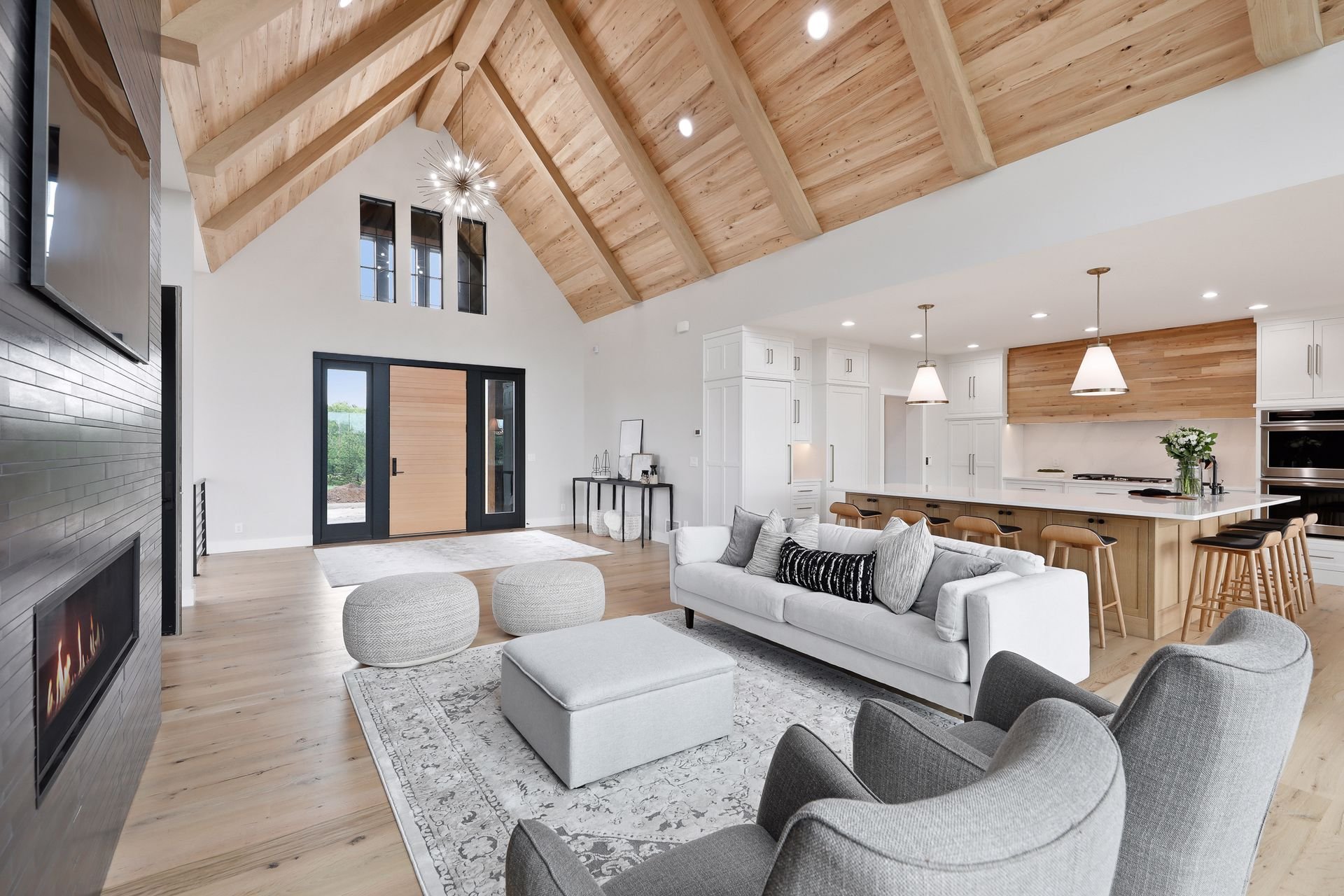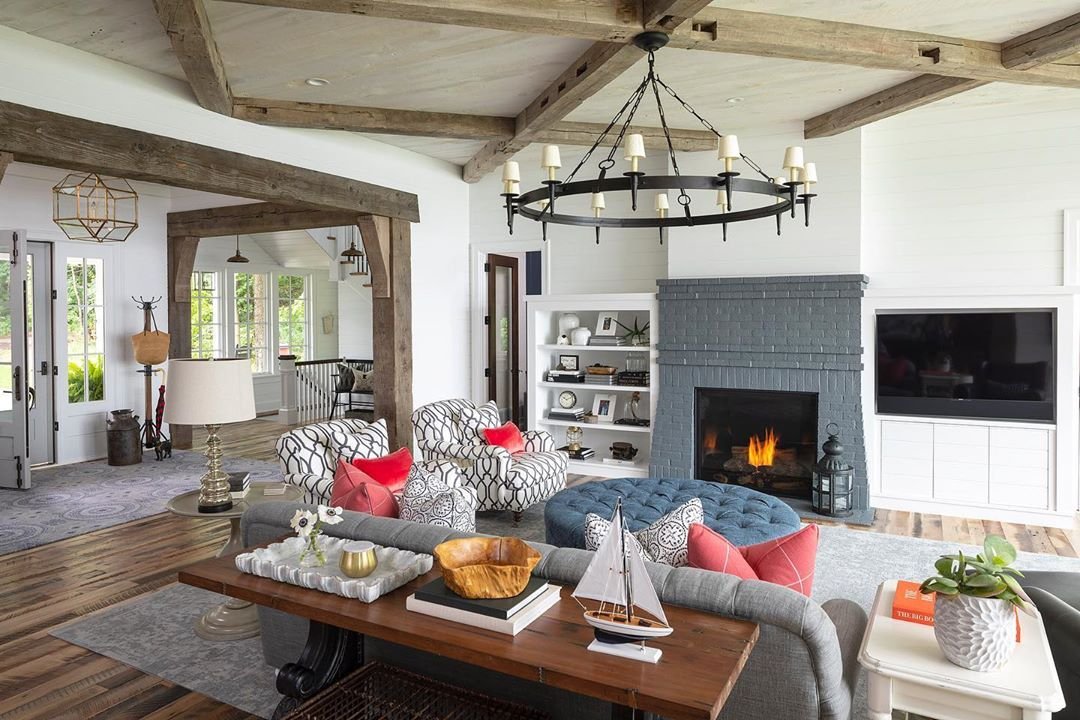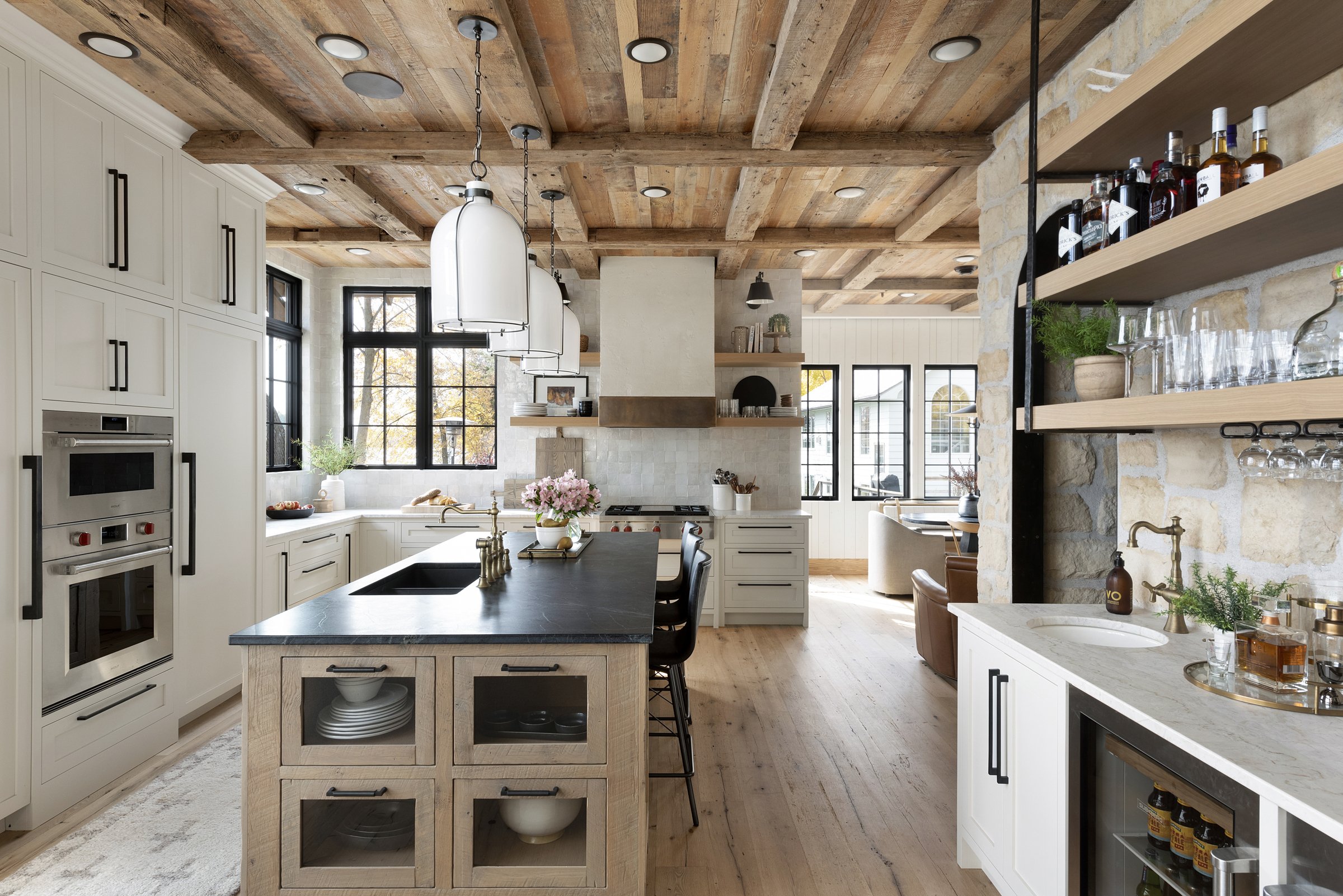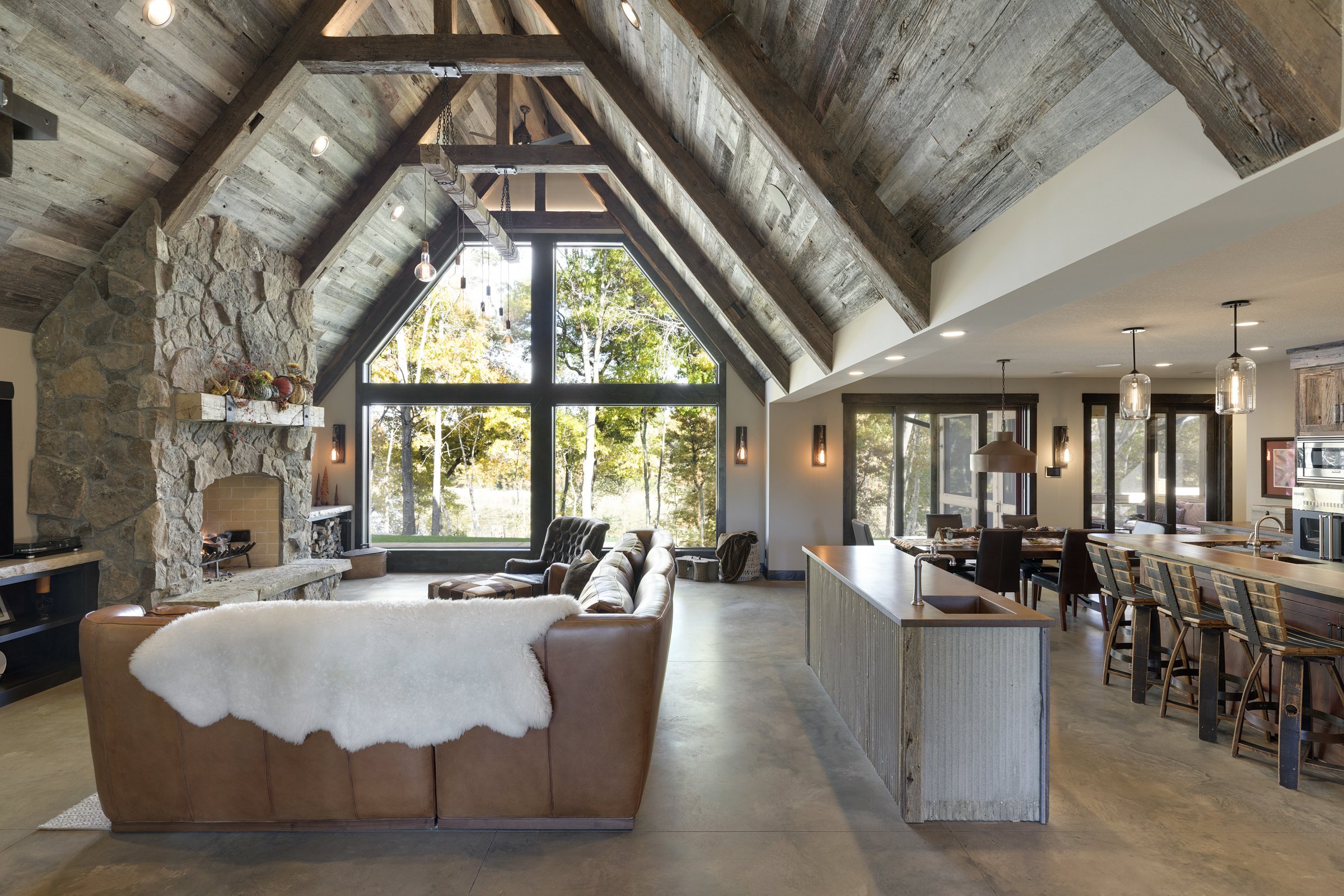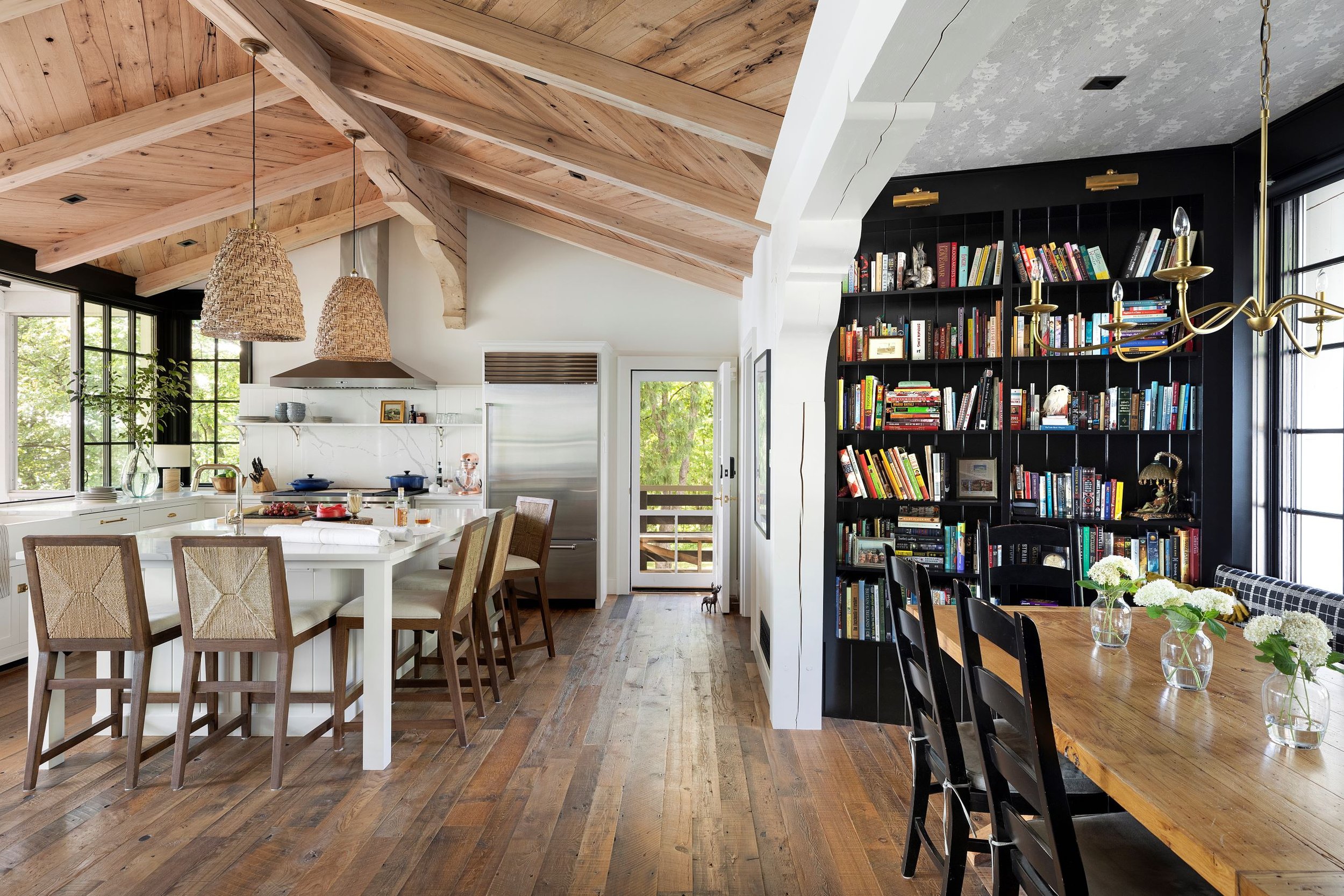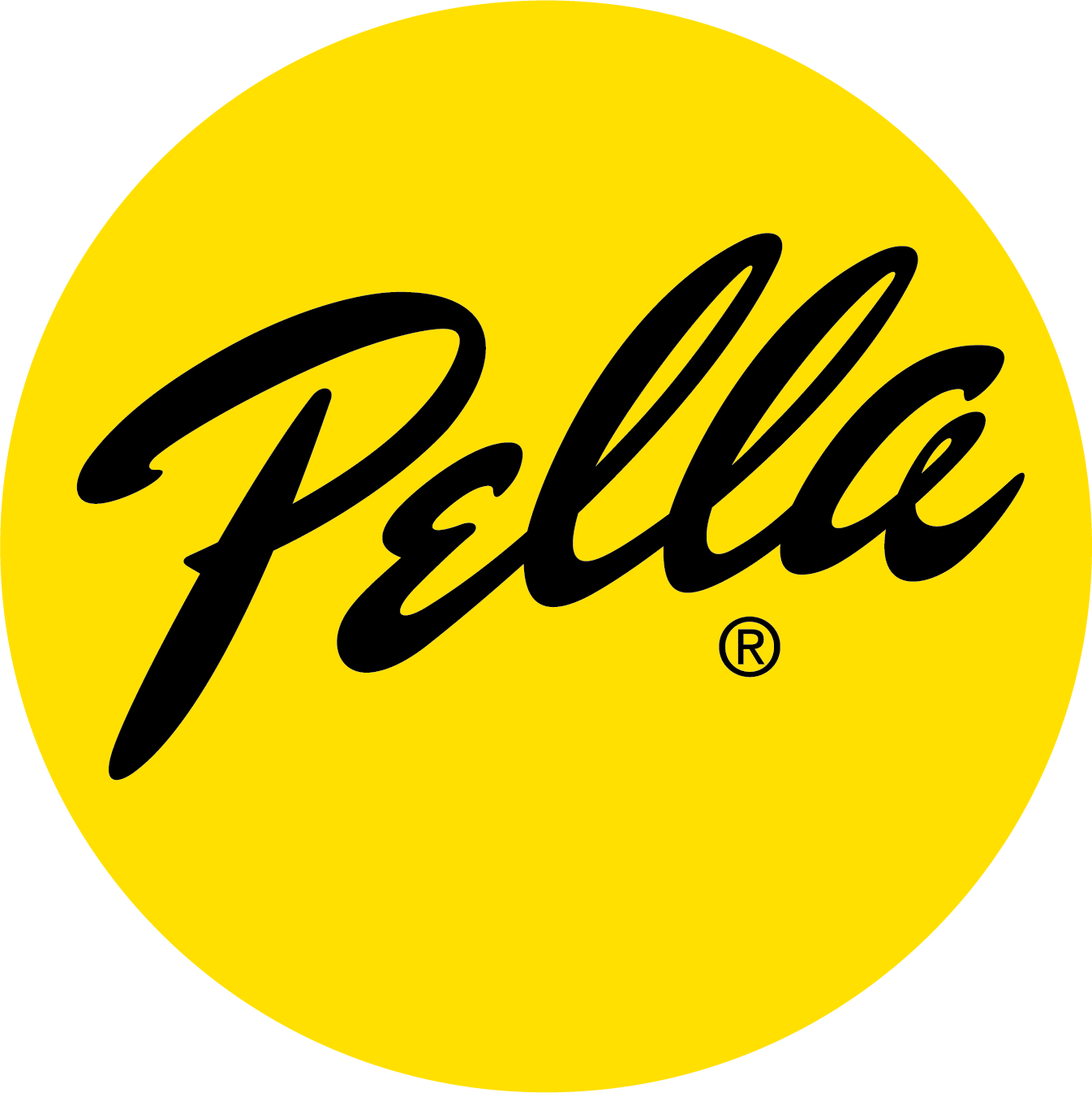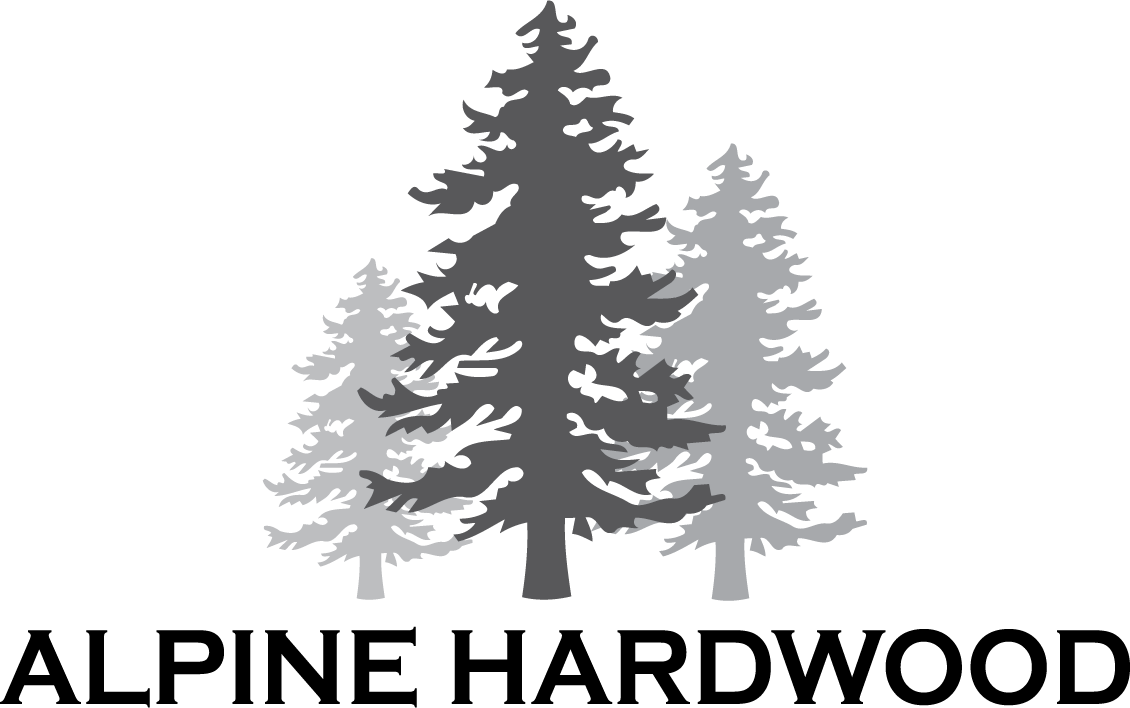Episode 10 - Sarah Londerville of Manomin Resawn Timbers
Episode #10 | Sarah Londerville | From Scrapyard Metal Scrounger to Fighting Chain-Saw Cowboys
Sarah shares her incredible family-centric story from salvaging scrap yard metals as a 1st grader to combating the "chain saw cowboys" with her expertise in sourcing the best barn wood in the Midwest. Sarah celebrates American history by salvaging our barn birthrights to provide them for modern homes. Manomin has put their barn wood everywhere from Punch Pizza and Caribou Coffee to Ralph Lauren in NYC to the modern homes near you. Sarah's depth of character is matched by her knowledge and commitment to creating a great brand and lasting business.
Listen to the full episode:
About Sarah Londerville
Sarah Londerville is the owner of Manomin Resawn Timbers, a Minneapolis-based millwork shop that specializes in utilizing reclaimed wood to make beautiful flooring, paneling, timbers, mantels, and box beams. For over 20 years Sarah has been working with clients to help them find the right reclaimed wood product for their forever home. She is truly passionate about reclaimed wood and how it can transform a space. Sarah has three adult children that she loves to travel with. When not working you can find her at the local Crossfit Gym, cooking or hanging out on the lake. She also enjoys the sauna and cold plunge.
Resources
-
00:00
Welcome to the curious builder Podcast. I'm Mark Williams, your host. Today I'm joined with Sara Londerville is the owner of Manomin Resawn Timbers. Welcome, Sarah.
00:07
Thank you. Good to be here.
00:08
You know we've worked with you now for I was just thinking about on the way over here today that we first met in 2013. And we were working on a home over in Excelsior for a client. And they had requested this beautiful barn wood floor that I believe they had as part of a family that was part of their family barn. And so that was how we first met. And maybe we'll just start start with that topic a little bit, because that's a pretty unique one. So her brother was on was at flight 93.
00:35
Yeah, and I believe so for 911. And actually, I saw his his photograph is up in the Bloomington high school where my daughter was playing basketball, I saw his photo there. And I was like, wow,
00:45
because I didn't find out till later, when we connected because when we were designing her home, she was like, I don't want this wood floors skip plain white oak, it was beautiful from their family barn. And as I understood the story, it was for his family barn. And obviously, he was the one that forced down that flight and saved countless lives as they were aiming for the Pentagon. And, you know, right here in Minnesota, so it's really touching was very emotional for the client, obviously. And so every time I look at that picture, every time I look at that floor, your product, I mean, we were getting pretty emotional right off the bat. But I mean, ultimately, your wood, and your product, and your story is an extremely emotional one. And so I think that's a beautiful thing in home building. And so anyway, that's how we that's how we first met.
01:26
It was really cool. I mean, I get very emotional just thinking about it. I think about it occasionally, because we had to hire somebody take on that barn. They shipped all the wood to us, we kiln dried it, we did everything. And so the homeowner would come in and check on the process. And at some point, she couldn't come in anymore, I would deal with her husband because it was so emotional. Because that's the barn that she and her brother played in when they were little. And then, of course, he passed away on the flight and on 911. So it was very, it was really, really emotional, right? Yeah, I mean, it was, I don't know, I just love working on projects like that, because it's so real. I don't know how to describe it. It's so real.
02:04
Right now. It's been 13 years since we've met our 12 years, I guess. And now. Now whenever I can I try to incorporate some barnwood and tell the story. And so maybe for those that don't know, give us a little five minute intro of you know, what is minimum Reese on timber? How'd you come up with the name and what services do you provide and then we'll talk a little bit more on the business side of things.
02:24
Some of them in recent timber were a reclaimed wood company we take originally started with just taking Douglas fir out of old factories and warehouses and milling that up and making flooring primarily. But that eventually changed and grew as we moved into a bigger location we couldn't really found ourselves the business with just Douglas fir got into barnwood set up a kiln and really started getting into other products, paneling timbers, just a wide array of products. So Mahnomen means wild rice and Ojibwe. And my kids, their their dad is Ojibwe. So it's a plan words. Yeah, like the last name rice, you know, little wild races. Yeah. So it's just a plan. It's a plan words, and I originally started the business with him with Jim. And then unfortunately, it didn't work out. And we sold the business. So back in 2005, we sold the business and I stayed out in that sales for four years. And 2008, one of the investors came to me and asked me to buy the business back in 2009. I'd said I bought it back. And the investor, luckily helped fund that. Because banks at that time weren't getting Yeah, that was
03:38
a rough time. It was a very rough time. Wow, that was a that was a pretty incredible. So here, the markets crashing and you're buying a business that caters to home builders.
03:45
That's what I said to him. Why would I do this? And it's amazing, because I just started calling builders saying I'm I'm back. I mean, I was always there. But now it's mine again. And there was a different way of the way the previous owner was doing the business versus me. I mean, I just really believe in just doing the right thing. We kind of butted heads a lot. And you're doing sales and you're making promises to people and I believe you just have to deliver on that. And that was tough. We didn't see eye to eye. The builders, I worked with both commercial and residential in the projects we did. People believed I think they they believed that I would do the right thing. And slowly but surely we dug our way out. I
04:27
mean, it seems to me, the business partners that we have, and you're one of them. The thing that stands apart with you know, as you go through this vetting process has been building for 19 years for ourselves, but ultimately, it's the relationships right, it's and I love stories and you know, we started obviously with the story of how we met and the story of that barnwood has a story for that homeowner, and I love taking things that are reclaimed and making a story but, you know, on a personal level, I love you know, it's it's beautiful to see other businesses succeed. And so you know, I see obviously I interact with you on a regular basis but you know, we also are a client of yours was, and you know, and we see each other a lot at trade shows. And we see we just see each other a lot. And so I love the real aspect of I think that's one of the most rewarding parts actually of our business, why I love my clients, of course, I love my trade partners, I just, I just love our industry, because I think Minnesota has so much to celebrate. And I think it's the relationships that you were just speaking to the integrity, the honesty, the vulnerability of just, I think that's what resonates with people. I mean, the reason there's a lot of places I could bind barnwood from, but I have a relationship with you specifically. And so for me, that's where I buy barnwood. And obviously, I have to run a business as well. But at the end of the day, the relationship is frankly, more important to me than $1 here, $1 there. And that's a value statement that I believe in. But I suspect it's the same for yourself. It is,
05:42
you know, we have vendors that we deal with that are, I like to find really good vendors and continue to work with them. But I take a lot of pride in the relationships we've built over the years with these builders. Sometimes I would be like, What am I doing wrong? Because for so many years, just grinding and grinding and working so hard, and I would lose out on a small, you know, at a fraction of a percent maybe or something. And having like, what am I doing wrong? What am I doing wrong? And I just decided like, this is the way it's going to be and we're just going to keep going. And eventually it's going to resonate with people. And it did. It just took time. I feel like part of it was the pandemic maybe because labor became short. And my model is we deliver right on the first time. Now, do we make mistakes? Yes, we do. But it's it's few and far between. We really want to deliver right the first time.
06:39
When you one thing that I want to get back to you and said you sold it in 2005. What did you actually start it with Jim?
06:45
So Michael was 21. Okay, and I was pregnant with him.
06:48
Okay, so 21 years ago? Yeah.
06:50
Yeah. So little over, it'll be a little over 2000 2003.
06:52
Somewhere in there. Yeah.
06:55
So that was full time before that. It was like part time just helping and because it's kind of a hobby, or was an idea, but not enough funding. I had a job I was working. Airport retail. I managed to attend airports. I was traveling all the time.
07:13
Interesting. So retail like what reselling
07:16
at the airport? It's all like, T shirts. trinkets? Yeah. So
07:21
you're managing retail? Yep.
07:23
Yep. So I had 10 airports, random about $50 million in business. Oh, my. So I was traveling out on the road. Like every day, you know, going from one airport to another throughout the Midwest. It was a lot of travel. And I just having baby number three, I didn't want to do it anymore. And one day, I just I was pregnant with Michael I just, hey, I quit my job. We're gonna listen to a business. Right?
07:45
What it is. It's amazing how many businesses are started with essentially creating a lifestyle that supports the family.
07:52
Yeah, cuz I asked him to spend every Friday home with the kids. Right? That's funny.
07:57
In retrospect, how, why barnwood? Like, how did what was the fascination? The specialty? Like how did you because now you obviously have a very successful business. Everyone knows who you are, and you have a great brand. But how did it start? Like why barnwood so what's there for Doug for
08:13
one of the things people don't even know I grew up in the scrap yard. I mean, scrap metal, and we didn't metal and steel. My dad had a full time job. He was a welder. But he never quite made he said that we'll never make enough money if I just do my full time job. So on the side, he was doing scrap metals, which really meant when people our customers are calling, I'm dealing with it on the phone. And and so I learned a lot about marking up and marking down because how old were you at that time? I think I learned I learned the difference between copper brass that like copper number one and number two yellow brass red brass. I learned all the differences by first grade. Like, that's amazing. So I'd start metal, like literally.
08:58
So that's six years old. My daughter is in first grade. So your six year old, telling you to be sorting metal. That's amazing. The
09:04
best part is when I learned in junior high about minimum wage, and I went to my Dad No. Okay, and then my dad just gave me an invoice for like rent and all my groceries.
09:15
What a great dad. That is. I'll keep that one in my back pocket for when my daughter asked for a raise, you know, 20 years from now?
09:23
Yeah, I totally like my dad is like amazing. I mean, he taught me so many things. So then, you know, fast forward, and the Douglas fir thing. I thought it was a really cool idea. Jim had sold a couple projects like a restaurant Tejas when it was at a diner. Yeah, that was all for all the stuff that he had did in there. And there was like something in the Mall of America. And I'm like, I really think we can make this into a into a real business. So So for several years, just for maybe three years, and then I realized we got to expand our offering. And I can see what's going on, you know through me magazines, there was not, you know, social media wasn't a thing yet, right? So I just started like, I mean, I'm always was looking through magazines trying to get ideas. And that decided let's get into let's start doing barnwood because I want it to expand our offering. And a lot of us playing around with it. And I think that's one of the things that I really feel strongly that makes us different is I've really understand the reclaimed wood. I understand that a barn doesn't have just one type of wood. So we call them you know, pickup truck guys, they're grabbing a chainsaw, chainsaw, cowboys,
10:36
cowboys, they go watch out Ice Road Truckers, recons, chainsaw cowboys, they
10:40
go tear down some portion of a barn, and they show it to an architect, and it just happens to be I mean, this happened in a real instance, you know, seven inch wide hickory, which what's one board, you know, out of the whole barn, right, and they think that they're gonna, like sell all this hickory, right, all of a sudden, that's not reality, it's not going to happen. And then I'm getting phone calls. And I'm like, okay, rally, that's not going to happen. But we can do this would which look very similar. And away we went. So a lot of it was just really understanding the nuances of what's really out there, what's available, how to work with it. It's just been a lot of trial and error.
11:21
You know, speaking of this, and I want to go through your process, because I actually don't know the answer to this, of how you go about procuring barns, like where do you source this? You mentioned vendors across the country, as in Minnesota. But before we get there, you know, right now, it seems like the last couple of years, you know, a lot of people will see barnwood real barn wood or reclaimed barn wood, and their age barn wood. And you can kind of tell us the differences here. But I also see a lot of wood that is treated, whether it's acid treatments, or paint treatments where it's faux barn wood, can you explain to the listeners a little bit of what the difference the pros and cons and what's going on there? Because it seems like it's a bit of a branding. I don't think a lot of times people even understand I think, like for instance, we do a lot of beams or mantle's right. And we had one home that we did, where it was just a ton of, you know, Wall paneling. And you know, a lot of barn wood reclaimed barn wood. But I think people want different kinds of beams, their accents, their decorative pieces, and I know you can do structural stuff as well. But I guess, I think the average person doesn't really know what they're looking at. Even me being in the business and using your product. You know, I can definitely tell the difference between real and you know, essentially manufactured barnwood. Where has that prevalence or what do you see as a fast moving trend between those two?
12:28
Well, I certainly see it when I go into the Parade of Homes, or I like to go to the tours and see what's going on. And I'll see the fake stuff. And to me, it's really consistent. It's more like getting a wallpaper. So if you're looking for a really a high grade of consistency, I'm gonna call it vanilla. That's just my term. Then,
12:49
we're just still I think, like one of most popular ice creams of all time.
12:52
I do love I do love a good Vanilla. Vanilla Bean. Oh, yeah. It's gonna be very consistent. Yep. And that think that's gonna be the biggest difference with reclaim that there's a nuance to it. Every board is unique and different. There's a story. And it's a part of Americana, America was settled by farmers. And literally, when people came to America, a lot of people got a plot of land, and then throughout the US, but it could be a lot in the Midwest, maybe it's 1020 acres, they got a plot of land and they built, they literally harvested the trees on their property to build that barn. So it's all different species. Within that barn, there's sort of be local.
13:31
So barn species would be pretty local. So like, obviously, you know, all buy it based on a look because that's what a client's trying to achieve. But it's almost like your example like, hey, Hickory, I mean, assume there's certain parts of the country that has more hickory or more oak or more whatever,
13:43
exactly, to where the wood grew. That's where the wood is going to be. So I have a source in Tennessee. That's where I get all my antique oak from. And my chestnut, what
13:52
do they call it the antique oak out of curiosity, versus Oh, it's just Oh, because well, I call it Antica. Well, it sounds way better for branding and marketing. You're spot on. Like, if I had a choice between buying Ultra antique oak like I'm all about antique oak. That sounds way cooler. And
14:04
I'll tell you, we do right now we're doing so many white oak X beams, antique white oak. We're bringing in these giant timbers from that area of Tennessee. giant giant timbers. They're sometimes 14 1516 inches wide, maybe 1012 inches deep. And we're cutting them up and we either make flooring or
14:25
or you have a sawmill in your facility. Yep. How big is your blade?
14:29
You know? Gosh, I mean, we can cut up to like 24 inches or that's pretty big. Yeah, it's it's a it's a bandsaw. Yeah. And it goes 20 feet long. Yep. So. So I'm trying to think of the direct dial. Yeah, no, you're good couple feet. Yes, we kill and dry everything. And then we heat treated for bugs and larvae. And then we build box beams out of that. And that's incredible. People argue with me. They think they're real timbers. Right? Because they look so great. Yeah, but
14:57
so you're taking but to be clear, you're taking a real term But you're playing, you're slicing it up. And then you're making a faux beam or a box beam, essentially a you for those that are listening, and then you were attaching that to the ceiling, and then you're mitering the corners in a way that can't be seen. And so that's where people are saying, like, Hey, that's a solid beam.
15:14
Yep. And we leave the cracks and stuff in the way. And the White Oak Hill, the Antique White Oak does not look like new white oak, I can't even describe it's so different. It's so incredible. The grain is so tight, it has a completely different look to it. It's just a very unique look. And, you know, we've had people say, Well, I want solid timber, I just don't want to do that order. First of all, it's super heavy to put the machines because they want to play in smooth. The second part is the OIC is so expensive, it's so expensive. And it's getting harder and harder to find that, I just want to get our best yield out of it. So doing the box beam.
15:52
And if there's really no difference, I mean, what whether it's an architect or a client, I mean, I would be probably biased as well, if you were to say, Hey, I would like a solid beam or a full beam, maybe it's just the word fo I think fake. Even though that even a solid beam applied, most of the beams that we're putting in are not structural anyway. So most of the great rooms are mantle's that you would see it's not holding anything up. It's like a tie on a shirt, it doesn't do anything as decorative, right. And so it's funny to me that we're so opinionated, myself included, that I would be biased towards a solid beam, because I think it's better, but it isn't any better. It's just heavier, and I can get less yield out of it. And it's more expensive. So frankly, the box beam is a far better.
16:29
And when they see how cool it looks, because of the checking that we live in that the worm tracking, and it looks so it's so cool looking that most people are like, okay, that's
16:38
an iPad. And you know, you kind of touched on a little bit the consistency of let's say, the acid treatment. So now, we'll go back to that here in a minute. So I've had clients on all over the spectrum, half of our clients liked the story. I mean, I myself like it a little bit more rustic, but maybe the style of the home is not that rustic. And so they want consistency they want, you know, they just want it to be more consistent. As you're saying, do you guys do treatments on that? Or that that'd be a competitor brand is a few pips, if you will,
17:03
we don't we've thought about it, quite honestly, but not the space. Yeah, we're, we've got about 28,000 square feet of space for inside of a building and boards like that have to be anything that's under two inches must be inside the building, we don't leave any wood that's over, under two inches outside,
17:20
just because it'll warp or age,
17:21
we don't want to warp and we don't want it moves, we really want to bring it in. Okay, kiln dried DNA, kiln, dry it, get it prepped so that we can start using it. We have 1000s and 1000s of feet of product just sitting aside, ready for the right project, not knowing what the next right product,
17:38
you probably would track what your best sellers are what you mostly push, right? So you're probably keeping an advanced portion of that. Exactly. And that you track it, you know, where it's like, Hey, I do an order of let's say, you know, 1000 board feet of white oak, antique white oak, are you just every month producing so much Antique White, because you know, it's popular, are you saying Hey, Mark just bought 1000 board feet of it, I need to replenish that. So I'm back to my.
18:01
So because of the amount of box beams and flooring orders and paneling orders, we're getting a white oak, we're trying to stay ahead of that and a habit. We try to have X amounts on the floor in the shop at any given time. But we might not have the right width. Sometimes that's an issue. You know, people don't really understand how much the beginning cost is met. One summer load of white oak is about 75 grand. Yeah, that's one load. That's the timbers now we have to cut it. And we got a high was pretty
18:30
specific. But it's actually I think people would interest in this. So obviously, when you if you do a model home and you're a builder, or you go get a loan from a bank, or you might have an angel investor, or obviously you've done very well you have enough cash to finance it yourself. But most people would probably finance a model home, I would imagine. And so people would get a loan, you know, as a business? Are you using a line of credit to secure this? Are you getting terms that let's say, is it a male, or whoever you're getting these, let's say this vendor in Tennessee, they're saying hey, well, we'll ship you up a $75,000 worth of white oak, and you have 90 days to pay it and you know, you can turn that in time walk me through the business terms of how that operates as a business,
19:05
different vendors have different terms. Okay. And so of course would never be simple. We have to have different rules. Everybody has different terms, depending on how what's their scale, as I think in the industry, it's very rare to get terms, but I've been able to build relationships over a long period of time that I've been able to get terms. So in that case, we do have terms, but the, the rest of the some of the other ones don't they're too small,
19:33
they need to be paid for and so those would be paid on delivery, essentially
19:37
some of our paid on delivery. So, you know, I might have 30 days because we would
19:41
normally pay 50% up front right? And I assume that covers that downstroke
19:45
cover that that's what we're trying to fund. But we have right now over $800,000 of inventory at cost just in between timbers and boards. So we have a lot we need to we need to have that big cuz we just never quite know. I mean, because of how business is so swift right now and busy, we try to let everybody know what you need to plan 12 weeks or 16 weeks, depending on what the product does. Some things like our best selling, like some of our floors and paneling, some stuff like our paneling is two week turnaround if we haven't stuck, but we might all of a sudden get a 5000 foot order, because we're all over the US. So we are shipping, you know, Washington, Oregon,
20:28
what percentage of your sales would be domestic to Minnesota versus outstate.
20:32
I'm gonna say Minnesota, Wisconsin, and North and South Dakota is going to be about 75%. And then 25% out of state, but we get a lot of hits from social media we get people are finding us and we're shipping stuff, too. We just ship stuff to The Hamptons box memes, you know, yeah, because they couldn't find anything that could be. They wanted a full, I think 10 by 10s. And no one else can do that. Yeah, they're all gonna be glue up. We were able to do that. So, but we also do a lot of commercial we're in a lot of stadiums. So we've been fortunate enough to be a lot of bars as well. And restaurants and restaurants, all the punch pizzas. Shout out to John,
21:11
they do look beautiful. Are they based in Minnesota? Yeah, they are. My kids are so good.
21:16
Yeah, my son, I should even say this because I don't want to take me up on this. My son has begged me to negotiate a deal that he gets free pizza for life. And I supply one star for free.
21:28
I'd probably be worth it. Frankly.
21:30
I'm not sure. He's an adult he has to pay for his own pizza. So no
21:33
wonder he wants to make that trade. But he should get in now before he has a family or anybody can expand it to everyone in the shop because their pizzas are very tasty, actually better yet to have them build you one of their Italian Napoli pizza Mills right near. Although fire and barnwood doesn't sound like that'd be a great we had plenty of what you do. You could definitely fire that thing up non stop. Yeah,
21:52
they're a great company. They're wonderful people to work with. And we were really fortunate. We started out with those Caribou Coffee and when John Puckett sold caribou, then he moved on, he found John Serrano, and they start a bunch of pizza, and they're just really amazing people to work with. And if, if you do a good job for them, they are very loyal. It's, you know, just that back and forth taking care of each other.
22:20
Are they out of chaos? Are they out of state do is are they just Minnesota? Right now?
22:23
It's only Minnesota. Okay, so they're but they're got a bunch of pizza.
22:27
Yeah, that's, that's fine. We go there pretty much every Monday night. After my daughter has dance. I pick up the boys from school. And then I meet my wife and we have Punch Pizza. So now we usually go to the one in Calhoun so I can tell you next time I'm there. So next Monday night, actually, I'll be gone next Monday. The two Monday's from now, I will take a video and I will post a story on it on the hears builder podcast,
22:49
the big giant communal table. Yeah, those are dug for.
22:51
It's funny, you say that I was literally just looking at it yesterday. So my wife wasn't feeling well. So I took all three kids. And that tables massive. That table must be 30 feet long. And there was a seam in it. But it was somehow joined together. And I didn't spend that much time looking at other than the thought crossed me was eating my kids pizza when he wasn't looking. It was. Wow, this is one long table. I wonder where they got this from?
23:09
We do three three inch planks. That's amazing. Do that. So yeah,
23:13
that is incredible. Okay, I love that story. Going back to tell me a little bit about the barn takedown. So I want to talk a little bit about your suppliers. And you know what percentage of the bars are coming from Minnesota or let's call it a four state area versus, you know, beyond that, I mean, where do these barns come from these takedowns.
23:28
We have one guy in Minnesota. Yep. We have a guy in Iowa that doesn't
23:31
know that they work for you. Or they're like a broker. They're their own person. They're their own.
23:35
I'm probably their biggest client. And then we have another one and Wisconsin, Central Wisconsin Central Wisconsin just has an enormous amount of barns. Sad story, my number one vendor for years that I got most of my wood from, because that's where we get our LM ash, a lot of our weathered antique material, all of our paneling from this one guy, and he unfortunately passed away a couple years ago. And he was just an incredible guy that we worked together for so many years. And it's really, it's really hard when it's like that happens, because when I went to his funeral, and everybody could tell it was a stranger from out of town. And somebody came up to me and they said, Who are you? And I said, Oh, I'm Sarah. I used to buy barnwood. Yeah, from Scott. And she's like, you're Sarah the barnwood. Like, yeah, that's me. She's like, we've heard all about you. Yeah, it was great. It was nice to meet his sister and sister and meet this whole family. It's
24:30
Did they have a family contingency plan to keep the business running or
24:34
want to do it? So unfortunately, that's a lot of work. That's what's gonna lead into my next question. He was the fastest person that we had, though that could take down a barn he could take on a barn for days, him and his crew yet like I think three guys working with them.
24:49
People often and and you're no stranger to this, but those listening and maybe future clients listening about barnwood is you know, people think, oh, it's reclaimed, it should be free or to be really cheap or you're laughing right now. And because we know the mean, I'd like that's where my lead in here is to just walk us through, like how much labor is involved. I mean, from obviously, you've already talked about when it comes into your shop, the shipping, the D warming, not the warming, but the kiln drying to make sure that you know, the bugs are getting out. Walk us through, like just how much labor goes into actually taking apart Barack, I'd be interested to know because I don't know, let's say you have to because a lot of the barns are in bad condition, I would guess. Right? So cleaning is really tough.
25:25
And if it's leaning or depending if the roof caved and they might not think maybe can get the siding, will they ever pull it down. And then they have to be really careful. Because once you start once a timber shatters, it's almost like toothpicks inside the timber. And so we won't accept shattered timbers and I have a really amazing way to get talking about our employees. I have an amazing timber yard manager, Matt, who's been working with us for I think it's going on 15 years now. And he is the person that accepts or rejects when wood comes in. Okay, and he's phenomenal at it. And he can tell if a timbers fractured. Wow. Because literally, when it's fractured the way it fractures, it literally creates like toothpicks. And
26:05
yeah, I get it. I've seen it. I mean, I've seen stuff where it breaks, and you don't know what you're talking about, even when you see a wood or in the woods. So if you're hiking like a tree that will fall down in that, let's say get struck by lightning or something you see that? Yeah, I mean, all the fibers essentially,
26:17
in those timbers are maybe 12 to 15 feet long. And that that happens in the center. It really it just damages the whole timber. It's not worthy. We don't want to bring it in. It's not
26:26
I mean, and I assume your vendors would know that as well. So what is kind of the rejection rate? Or they try to sell what they can
26:32
they try to sell it, they can sell them, you know, so it's a lot of education, and you just are educating them on every single delivery. And then others, like my guy out in Tennessee, he's super sharp. And He is Generous, he always shifts a little extra. He's a great guy. Some of them are always it's always short. And always, there's always a bundle missing. Yeah. It's just part of the business. Sometimes I've had employees, I'll hug you know, it's frustrating for the employees, but I grew up and US metal scrap yard. At six years old. We had that coming in every Saturday, people would bring in their stuff. And I could pick out it right away. You know, there's people out there, they're super down and out. My dad was very generous, way more generous than I ever felt they should be with these people. But I learned how to deal in that environment. So I feel like it's really helped me. So I
27:32
That's my really early training, but 10,000 Hour Rule, you had that by age 10.
27:36
But now I'm kind of dealing that same Yeah, some of the people are somewhat the same sometimes. And I just understand how to deal with it. And it doesn't doesn't bother me, it's I have more empathy for me, and what they're going through and want to relate, train them and work with them on how we can work with them. Because I'm like, This is how much I can buy from you this year. I let them know up front. And when they understand the value, and that the money is going to be consistent, then it it's like not let me let me help you get there. Right, you know, and it's going to be a win win for both of us.
28:11
I want to talk a little bit about how these vendors go about actually securing bonds and other people's properties. That'd be my second question. But I still want to go back to how does a barn get taken down to the start with the roof like walk me through like the disassembly of a
28:24
barn, the barn, they're usually going to start with taking off the siding. Okay. And then so they're using crowbars like how are they doing? They're just using old Yep. in their tracks, a lot of manual labor manuals, all 100% manual and they're trying to do it where the they're not breaking the boards because we want the boards and tap so the prying them gently. So they have to get up there peeling all that off, then next would be looking at the roof. Now if the roof had at some point cedar shakes on it, they either have to have some other customer that will take those barn roof boards or they know I won't take them what? 1 billion nails. So all these things I found out the hard way. By watching somebody like finding out that somebody took you know, 45 minutes to the nail one board and still and got half the nails out. There's no way you can become you can't make a profit on that. The boards are beautiful, they're usually wider. They're big boards, because they I would imagine when you're building the barn, you want to have the widest board possible to help you clad it as fast as possible for that roof. But those cedar shakes those nails just rot off inside and they're just a nightmare. They're just sitting in there there's hundreds of them hundreds you know so
29:30
and plus with a if the head is off of this nail broke so now you have the shaft embedded in the wood and that's how would you how would you can get that out anywhere. Literally, you'd have to would you have to actually hammer nail through
29:40
like with with like an awl? Yeah, something like that. Just to try my
29:44
word. That does sound terrible. Yeah,
29:47
it's not worth it.
29:48
I mean, is that a product that anyone would ever want with the nails and hard for us
29:51
to move but I know there's people that will you know, hobbyists will take boards but we're not
29:56
that yeah, business. You want scale and why? don't have to be scaling.
30:00
Yeah. For the volume for our employees, right. And I'm like, it's not just me, I've got 20 other people that depend on me for a paycheck 20
30:08
employees can't see it, there's a knuckle bomb. That's impressive.
30:13
So they peel that off. So they'll take a look at the roof. And they'll make a determination if it's something that they can move or not. They know right up, everybody's like semi daily boards, they're going right back on the truck with you. So don't waste your gas. Then they get that killed off. And then they're going to take out strategically remove certain pins in the barn, because typically, it was part of some tannin, and they're gonna tip it, they're gonna use like a vehicle or some kind of a left that's going to gently tip it to one side or the other. And then they're able to pick off the beams
30:48
gently, I bet comes in a variety of ways.
30:52
Well, they know like, if they don't do it rightly then yeah, they've lost STL. Yeah, so and they're actually I have to say these guys are really good at it. Because we get really, we have really nice timbers. Your stuff is
31:03
beautiful. Amir showroom is incredible. If you ever up in Hugo, Minnesota, or just want to see barnwood in general. I mean, no, it's truly it's incredible showroom. Actually, I should go back there. It's been a couple years since I've brought a client and stuff. Yeah, well, I know my I mean, I usually will send the designer up there with the clients to you know, to go look at it. So I don't get as involved with selections as I used to be, but just from a curiosity standpoint now more interested manufacturing. Oh, yeah. Just to check it out. You know, how you do it, it was find that interesting. So anyway, so the barn, they disassemble it, they D nail it, if necessary. They
31:33
take the surface nail it, they take off the surface nails, we have to go through it. So So then they load up their trailer and bring us the material or they might start for a little bit until like a quantity. You know, the one thing I don't like dealing in small quantities either I like to deal in larger quantities, I want to full full truckload, you know, I want to maximize our shipping costs, you know, as well, so we're trying to maximize all that. Then when the wood shows up, we got guys, you know, they're forklifting it off. And then they're taking inventory. And there comes a how
32:10
do they do the inventory though species and the length or how does your inventory process work
32:14
there. It could be timbers, or you know. And then we have different styles of timbers are hand healing or weathered antique timber. Basically, those are the two types of barn timbers. But they'll also note if it's hard water soft wood, because sometimes it could make a difference for weight. Depending on what kind of a building it's going into. For
32:32
those listening, can you describe the difference between software and hardware just for
32:35
so soft woods is going to be a coniferous trees and like red pine, white pine, trying to think of some hemlocks. And then your hardwoods are going to be ash l could be oak, maple, birch, and the hardwoods boy a lot more, we use an average of about four pounds per board foot, just to give us an on all timbers just so people can have a plan when they're, when they're working with their framing, we like to start really early in the game and make sure that their framing is setup that they can handle this,
33:06
I suspect that a constant problem, just knowing because I've done it this way is that barnwood often ends up becoming a afterthought, or like a wall treatment or an accident. And it's often not discussed early enough on the design or architecture side. Is that an accurate statement
33:21
that that is? Yep. But we also work with, we work with really amazing architects to that. That spec a sense early in the game, which we start discussing. I mean, I love having meetings before they have started digging a hole, right? Because then we can really plan out all the ways we can plan everything out. And there's no surprises down the road. And more and more frequently. That's happening where we're really
33:47
often again, what percentage of your sales would be decorative? Versus like structural? I mean, do you guys do structural?
33:55
We can we can supply structural stuff, but I would say like less than, like 5% Oh, wow, everything is decorative. Interesting. Wow. It just, it's just so much less expensive than trying to do a timber frame project.
34:09
We've only done one in our career. I mean, it was a, you know, the timbers came from Montana by train, but they were new, I believe. And I think it does
34:15
refer to Yeah, sorry. Yeah. How? So?
34:19
Transitioning a little bit. So you know, you mentioned before social media, it was a way that a lot of people find you. And you know, we obviously have a mutual friend. She's been on the podcast before Morgan monitor with construction MyStyle How long has she been involved with kind of your social media side of things?
34:35
Well, we were with a company that Morgan had worked for, but but didn't know market. Morgan had already left that company. And I actually got introduced to Morgan from Jesse Kath. Yeah, sure. So Jesse and Katie were dating at the time and came to my booth at the Home Show. And we were talking and I was jealous because Jesse had quit doing booths. was still there doing a booth. Yeah,
34:58
they were they were actually I think is number two. So they're fans. Yeah.
35:02
I love them. They're a great couple. Yeah. Really? Their power couple. Yep. They're so cool. And so they were walking around with Morgan and her husband, Jamie. Yeah. And I'm. So I didn't really I'm like, Oh,
35:14
how many years ago would have this?
35:16
I was still doing home shows. I don't know how many years, six years or five years ago. So I looked her up. And then I contacted her. I think I just kept bugging her like we take me on as a client. But I don't think she had any clients said, no, she was only gonna have four clients to start with. And they were doing their remodeling business along with all the other stuff, her blogs and everything she's doing. I think I just kept bugging her until she finally gave up.
35:41
Because now it's kind of a you know, it's becoming a bigger part of her. Shout out to Morgan monitor with construction to style. I mean, they do it. She's got a lot of energy. She does are involved in the few groups together. And yeah, she brings the thunder. She does
35:54
it. She's like, super on track always of what's going on in the industry. She's just really amazing. So they now handle I just turned over my SEO to them to for our website. Yeah. About two months ago. Yep. So that's really exciting. I originally kept that split, because in the past, I had issues with putting it together and not getting the service I needed. Sure. But I just feel really confident with Morgan, I'm not gonna have that issue.
36:20
Wow, she's got great vendor relationships, and a big part of like any firm, you're buying, not only them, but the brand, but also their network. I mean,
36:26
her network. That's right. She networks with all these different companies, or I'm gonna call them what he called them, having a micro influencers, influencers, like all these influencers that are working on their own homes. And then we partner together with Box beings are different projects. It's really fun.
36:46
So on that front, so I was curious, I've noticed in I'm curious if it's just me, you had mentioned earlier in the podcast that you know, you've had a big, just in terms of sales, you know, we're recording this right now, end of January here of 23. And obviously, the last six months, from my point of view, things have definitely slowed down, because there's a lot of interest, but people kind of want to wait and see motion. What are your projections looking like even this year, compared to last year, in terms of, you know, sales? And what are you seeing for interest?
37:14
We had 2020 was our biggest year ever. It was a phenomenal year. We a lot of it's a lot of really large projects that we worked on during that were really fun projects, a lot of collaboration with architects and designers. This year, we have we have a third of the year already, like on the books as far as like, I've been told yes. And I really want to when somebody tells me yes, it's going to happen. I really believe it's happening. Because there's so much work that's gone into the the prep of assets. So that's, that's exciting. So a lot of those jobs, though, are out like Thermore summer fall. Yeah, just because the projects are so big, right.
37:55
I mean, the project. I mean, obviously, if it's a bigger home, I mean, it may have started two months ago, you know, I mean, it might not even be it's probably not ready for your stuff, right? Because the bar was probably coming on, you know, during the trimming phase,
38:05
and I'm also a very, I will not ship something early like that was like, Oh, we can put it in the unheated shed with, you know, no concrete. And I'm like, Nope, we're just going to hold it. I really want the product go out, right? There's not gonna be any issues. I'm like, I'd rather just hold it. But it's always interesting how they're everything ebbs and flows, you know. So we have these several big projects that are new, large, high end homes, but then all of a sudden remodeling starts taking off. People want to work on their own home. So we get that influx, but it's really interesting. I feel like the commercial market stopped during the pandemic. I felt like it really stopped and they're obviously no restaurants. We have so many commercial projects in the works right now. It's crazy Sioux Falls off to Sioux Falls, South Dakota. Yes, we have, I think three restaurants doesn't matter. We're going to be going in alone just in Sioux Falls in the next couple of months. But or tell
39:02
the Punch Pizza guys or go to Sioux Falls. That is your son's gonna go there for free pizza,
39:07
you know, quite the market place. Yeah, we did a really big project with a restaurants here that's in the Twin Cities here. And he opened up a place in Sioux Falls couple years ago, but so I'm really excited because we have so many commercial stuff.
39:22
What I love what I love about your business is the fact that you are not limited, you know, geographically. I mean, you're shipping stuff all across the country in your relationships, obviously for myself, you know, I can't build homes out of state because my network isn't there. I mean, I've not worked with the but the people that can actually help me produce the home because it takes so long, you know, it might take a year year and a half to build a home. You know, I'm kind of limited geographically unless I was to you know, expand open up satellite offices.
39:46
It did kind of at that hurt that when the gas prices went way up. I mean that made it hard for country pass long shipping. Why would that? Shipping can be three or four grand, to be honest,
39:57
but it would kill the sale or because obviously if I'm a Sioux Falls and it's all brand more. I mean, you would, you would pass that on to the client, right?
40:04
Yes. And they're, they don't want to pay that shipping. So I would kill it that would kill the deal. Yeah. So that's one of the issues we ran into, like, within the last two years, maybe just the gas prices going up exponentially, really did hurt a lot of our long distance job. They decided to wait, because it's going to add two or $3 a foot to their floor.
40:26
How much do you see out in, let's say, like, we had a cabin in Montana for 23 years? And you know, I see a ton of barnwood, obviously, in these western states. Do you guys ship much to there? Or is it mostly, you would obviously have competition out west. And so they're buying mostly local farm goods from let's say,
40:41
there's not a lot of barnwood at there. There's not a lot of farms there. So they're shipping the stuff from the Midwest and they're shipping they're getting it from the same people like interesting because they don't have if you think about farming out there, you know, dairy farms, dairy barns, those are the barns that were everybody's going after for the barn wood. Why dairy bonds, because they cause the cows came inside. So they had to build their bearings. And when you're thinking about cattle farming, that's really more lean tos. They're not building. The cattles are free range, you know, they're not.
41:13
That's a very interesting fact. You're 100% Right. Yeah. So
41:16
there's not a lot of big barns. They're just small, smaller shed like structures, so they don't get the word from there that one's got to come from.
41:24
It's interesting that that's that style, so prevalent in Western architecture, that barnwood is but yet barn wood is very Midwestern.
41:30
It is a very good source. I think that rustic nature of just the inside of the barn, the brown tones, yes. You know, the rough cut of the wood. Because I mean,
41:38
if I was to close my eyes and picture like an idyllic like town or setting would it be a lot of Barnard I think of like Jackson Hole or Whitefish, Montana or Colorado, but
41:46
it's seen a barn driving around there. No,
41:48
other than the famous red barn that you see in front of the Grand Teton. It's like on every postcard every photo, my sister and I climbed the grant Oh, I don't know, 20 years ago, and it was funny. We were looking for that bar to try to capture it. But it's that's the very well marketed bar on that one.
42:03
And that's about that's probably one of the Oh, yeah, you just don't see barns. area. So yeah, so I can say we probably don't sell as much material to Montana, because they've got several reclaimed companies out there. Yeah. It's more like when they're really desperate, because they can't meet timelines.
42:22
That's whenever Canada I mean, do you have a lot of barns up the road? I've
42:25
only shipped to Canada a few times. And it's always through kind of International Falls area. So that's that area. I would say a lot on the east and west coast, though. I mean, we and we've done a lot of commercial stuff. That's
42:38
huge percentages, commercial versus residential,
42:41
probably 30%. Commercial, it kind of depends on the year, it ebbs and flows.
42:45
So there, but and then from a revenue standpoint, would it be higher split? Because I mean, that's percentage of job would be commercial, but because I'm guessing the jobs are bigger than the residential houses that are true. It depends.
42:55
I mean, there's right now we're working. You know, there's so many big projects going out of their homes. And then, you know, our biggest was our commercial project was Ralph Lauren. We did that flagship store in New York City. Oh, wow. But it almost killed me. I mean, it was like, the worst job I've ever worked on hold. Because of them or anything. It was just such such a tough job. I had to find specific wood. It was coming out of a mill and Alabama. And it was coming literally out of old textile mill that had been shut down for 40 years. It was like a million square foot mill crazy big. But I had to fly down there repeatedly. To get the people that were getting the word out to like, light a fire under them. I'm like, it was so painful. It was so painful. And then here I am find Atlanta rentacar drive to Alabama. And I'm like, why would these gas stations in the middle the country have bars on their window, I'm like, here I am driving around going. I can't believe I'm driving, you know, like sending a text message to the office. Here's my last known location. I'm meeting these two guys in a Walmart parking lot. And I'm going to drive to go look at this mill. And these two guys pull up and they're just this big guys and old rusty vehicle and they're like, Hey, you want to jump in and ride with us? I'm like, I'll just follow you. And I'm going to a place with no electricity and we're gonna have a wall. Why don't you have a flashlight? It was like crazy. And I'm just like, what? Some days? I'm like, What are you thinking? What are you doing?
44:29
I don't want to see what a milk out of milk carton for missing persons. So bring a flashlight that now I know to bring some muscle next time.
44:37
So it's pretty funny, but we ended up doing a really big project with them. But boy, it was a lot of
44:44
what was the connection? How do you get connected with Ralph Lauren?
44:46
It was actually through their millwork company. So as a millwork company out of Long Island, New York that hired us.
44:53
Wow. I mean, that's credible. You think I mean, if I was them, you think well, cavemen would you look on the East Coast. I mean, do you have that? Buying a brand or,
45:01
you know, it's just all like literally over the years, I've met so many people, and it's kind of crazy. And it was a guy that I worked with, that had a millwork shop in Wisconsin, he had not made it through the 2008 turned down. He went to become a salesperson for this company and remembered me and said, Hey, sent me some photos. And I'm like, yeah, we can do it. And I was trying to do out of favor. But Southern Yellow Pine is what it had to be it had such strong graining that I knew that the southern pine was the only one that was going to work for what they needed. But then I had to go find it.
45:37
How often you in a normal scenario, how often are you actually going to see mom before the teardown or is like your vendor.
45:42
So I never really do that anymore. I used to back in the day. Now I just don't do it anymore. But I don't have the time. Yeah. And now it's like, this is what I need. This is what I'm looking for. In this case, this project was so big, and it was going to take about a year to do because there was multiple applications. I just had to make sure the wood was right, cut some of it up, and then figure out how we're going to time everything out by getting it dried, we had to find a high speed kiln in Augusta, Georgia. I mean, it was like a lot of work to get the product shipped to the high speed kill get a try. And it took like five years
46:16
off my life. So in other words, don't do another one.
46:19
I thought this was gonna be the graving or the icing on the cake. Right?
46:22
This is no big deal. I think I think a lot of us can relate to is that anytime you have like a big name or you chase like this cool brand, I mean, you know, and someone has one cents, you know, Chase experience, not dollars. And you know, that being said, it seems like a lot of times when you chase the experience? Well, I think long term is beneficial to your career. It's a feather in your cap, you obviously learned a lot. I mean, it doesn't mean that it doesn't come without cost. Those projects are rarely the ones who make money on
46:46
yep, yep, exactly. And I probably, you know, I lost sales, because I didn't take care of like there are a lot of clients that, you know, homeowners that have seen us over the years that we were too busy to work with them, because we didn't have the capacity. So it was a letdown, to say, but you know what, it's a really good learning experience. Because now I know I'll never do that again. Because I need to always make sure I'm taking care of my core clients, because a builder did say to me during this whole event, and I won't mention his name. He's retired now. Great guy. He said, Don't forget who helped you when he needed help. When I was getting back in 2009, when I bought the company back, he was the first phone call I made and he would just buy. There's nothing going on. He built like three homes or two homes. They put a mantel on his house just to help me out, you know, and he's like, don't forget, and I'm like, I'm so sorry. I felt like I was like, I don't know, I felt like I was disappointing. My dad when he
47:41
told me right all the disappointment speech.
47:43
That's the worst was bad.
47:45
Now your son is involved? are multiple family members involved? That kind of that you mentioned employees and kind of transitioning back to your inner
47:52
team. Well, what does that mean? My son over Christmas last years, tried talking to sisters into like just quitting what they're doing. I'm come work for us to be the dream team. Yeah. Because we have, you know, you raise your kids a certain way. We have the same mindset. And I have amazing kids. But my oldest is a school teacher and middle child still in college happens to be in India right now. She's sends me lots of messages. She's doing her a term in India. Oh,
48:17
wow. What's your going to school for?
48:18
Business? Okay, but not to work with me. Right? Because she's, she'll tell people, my mom, will you let me file and clean?
48:26
Oh, funny. Well, yeah, that can change that we interesting. We actually, we had Mark shear from sure brothers on and their whole family is, you know, not all of them. But a lot of them are in the business. And one thing that we shared on that podcast, which is pretty interesting is they they make them all get, they have to work, I think it's three to five years for another company and or a major promotion before they can come work for the family company. And the idea is to promote growth, bringing assets and not just have, you know, essentially not be so insular. Like having bringing ideas I thought if I had a family run company, which is another reason why I don't want my kids to get involved because that mean if I have five years plus them to me, I'd be like 75 Before I could finally get rid of it. I don't want to be still this is a this is a lot of energy in this game. So.
49:09
And my son, he's 21. And he joined right after like, honestly was right. He was graduating high school, the pandemic was going on. I had some guy coming in to rip apart all our machines and to go through everything. And I said, I need you in here during the day while he's here. You do your school at night. And he was all on he loved it. Yeah, he had this really mechanical. So he loved it. I had a production manager was very challenging having a lot of issues with this person. And we had a company picnic and outside because it was during the pandemic. And after everybody's done eating, they're like, Hey, we're so and so. And I'm like, Oh yeah, that's why we're here today. This person is no longer at the company and my son jumped up and said, let me grab a notebook. I just want you to give me one shot and that was a year and a half ago. That's incredible. I've actually loved that one shot and I'm like, okay, and honestly He has made my life so much easier because he understands like, what the goal is the goal of delivering the product right the first time, but he also understands waste, and it's not just like a spendthrift. And he's like, thinks about what he's doing. And it's been a breath of fresh. What's his name? Michael. Michael. So you met him at that? Yeah. Yeah. Cool. Let's just call it Shannon. Yep. He remembers you. Yeah. That's a funny guy.
50:28
Yeah, don't stare on me too long. Because all the jokes I ended up being the same. So all right, dad jokes and force.
50:33
But over the years, we've built like a really amazing team. You know, Julian, our office, I'm sure you've talked Yep. I've talked to her a lot on the phone just been promoted to director of operations. She's really amazing. I mean, we could never be where we are today. Without her. She does all our takeoffs. And her team does all the quotes and estimates and she manages the timber yard manager and dislike she's just really amazing.
50:57
Your your day to day? I mean, so you're doing business development? Or what is your
51:01
day to day I do I still deal with a lot of sales stuff i I still am heavily involved in checking product for certain clients, when we're on these big projects that I've worked on. I'm like, my eyes are going on to approve or disapprove of, of what we're going to use. And this business development, just an array of things that a business owner does. We have, you know, accounting personal time counting person, but in the office. Yep. But I also am still pretty involved in that. I like to know where we're at what we're doing. Yeah. So
51:34
it's a business owner, you have a bit of everything.
51:37
Yet, when we got one of our guys, it's been with us for 15 years already. That's our timber yard manager. He's our safety manager. He's like, he's really a manager of everything. But he doesn't want to be a manager. So we just pay him like a manager. So he stays. Yeah. He's really great.
51:54
Oh, man, that's amazing. What are the next five years? 10 years look like for you?
51:58
Well, I'm always worried about running out of wood reclaimed wood. And so then I start thinking about what are we going to do that's different? I just, you know, we like to just watch what's going on in the industry, what color? What are the colors? What's happening? I'm always worried that we're going to start running out of like, oh, people are going to stop using reclaimed wood. But it's, luckily, you know, you get Restoration Hardware magazine, and all of a sudden, you know, they always got timbers added or reclaimed wood. And I'm like, oh, yeah, we got another year, another year. Yeah. But, you know, my goal is that we're gonna plan up doubling business in the next couple years. Wow, based on volume, we're looking for additional space,
52:36
we'd be we'd be able to adjoin where your current spaces are, will have to be another foundation nearby,
52:41
we probably ended up having to get us another location for storage or for space. Yeah, we really need to get a bigger killed setup, or what we're doing, it's taking up too much space in our location. So we've got some things in the hopper that we're working on. And that's where my son comes into play. Because I think it's you know, this will be a great investment for him to buy property an
53:02
I love his gumption is go get him I love the fact that at the company picker, he like grabbed a pen and paper, we'll just play that's like any business owner. I I'll just speak for myself. One of my pet peeves is when you, you know, I think most business owners are afraid that we want to get our ideas out. But we're also don't want them all to fall to the ground. And so having record keepers, people that hold you accountable people that help track your ideas. So I would tell your son in a second tell him the funny guy would hire him because I love the idea that he took the initiative to stand up and be like, right in front of everyone. Hey, I want this job. Give me a shot. I love that.
53:32
He always says to me, I don't I don't know how to do this. And I'm like, Yeah, neither do I. So Scott figured out, I said, nowadays with Google and YouTube, and I mean, you can figure anything out. So I don't know if it's a quick read down, or we've got some kind of a problem. You can figure it out.
53:48
Kim, who you met on the way in here today from Senan sons shout out to her but she said her superpower is problem solving. And so I mean, I think every business owner needs that superpower. Because ultimately, it's like, you know, people who come to me and you know, as a as a general contractor, and I often tell them, like, I don't know the answer to that. But I know who will I know how to get it. And so I mean, I think that's even as a six year old, you processing the scrap yard for your dad. I mean, ultimately, that's, that's you're figuring it out. Right? And that's a he is an extremely valuable skill. I remember somewhat akin to that was, you know, obviously, way before cell phones and everything. My dad was a builder, and he used to make my sister and I make all his phone calls for him at night. And when we got home from school, and I remember not liking it actually that much. But and I don't know if he had a master plan or if it was just happenstance. But he'd say, Hey, call, you know, Mr. Johnson, get them on the phone. And I remember just like, This is so irritating. And so I'd call the number and I'd be like, Hi, Mr. Johnson. This is Mark Williams. My dad, David would like to talk with you. Okay, hold on. And then I would say Hey, Dad, you know, Mr. Johnson on the phone. And so but I never thought about that. Until, you know, when I got into business, like that was actually a very valuable skill. Not to be intimidated. I would have been a young kid, you know, you know, I wasn't selling scrap metal like you were but anyway, just it's amazing how much parenting and how much just like empowering your kids. Like, hey, go figure it out, go do it. And then I think that's really beneficial. Hopefully it doesn't get lost in the next generation. Because I think it's a very valuable tool for any entrepreneur. It really is.
55:09
We had some timbers that we couldn't get apart at our shop that were had these, they're a bridge timbers and their giant bolts through it. And I'm like, This is what we got to do. But then people are looking at me like, I'm like, How would you know? It's just funny because my dad came out to visit me and he came to the shop and then he's like, I was talking these timbers and he's like, are you serious? Are you you're telling me that you got these group of people they're telling you they can't get apart? And I'm like, and he just like, shakes his head and walks away. You know, because there was like, that was never an answer, like no or you can always figure it out. Just put your head to it, you know?
55:46
Well, we're out of time or probably overtime knowing us you and I could talk for days Thank you very much for coming on the curious builder podcast. Where can our listeners find you?
55:55
You can find us at Mr. timbers.com Mr. timbers. Yep, Mr. Timber sharp for Mahnomen Reese on timbers. Mr. timbers.com and Mahnomen Reese on timber is our IG Instagram handle and we're on Facebook as well my my recent timber
56:10
and for anyone also looking in the show notes and on the curious builder podcast.com website. You'll see all of our notes, you'll see our YouTube video between Sarah and I, you also see all of her handles as well. So thanks again for coming on. It was a pleasure to have you Thanks










